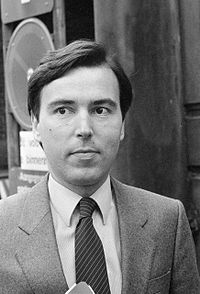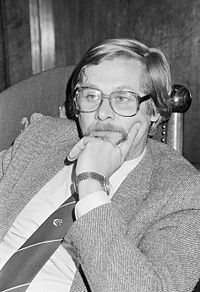- Christian Democratic Appeal
-
Christian Democratic Appeal
Christen-Democratisch Appèl
Leader Maxime Verhagen (Ad interim) Chairman Ruth Peetoom Leader in the Senate Elco Brinkman Leader in the House of Representatives Sybrand van Haersma Buma Leader in the European Parliament Wim van de Camp Founded October 11, 1980 Merger of KVP, ARP, and CHU Headquarters Partijbureau CDA
Buitenom 18 The HagueYouth wing CDJA Thinktank Wetenschappelijk bureau CDA Ideology Christian democracy, Conservatism Political position Centre/Centre-right[1] International affiliation Centrist Democrat International European affiliation European People's Party European Parliament Group European People's Party Official colours Green Senate 11 / 75House of Representatives 21 / 150States-Provincial 86 / 566European Parliament 5 / 26Website www.cda.nl Politics of Netherlands
Political parties
ElectionsThe Christian Democratic Appeal (CDA) (Dutch: Christen-Democratisch Appèl) is a centre-right Dutch Christian democratic political party. It suffered severe losses in the 2010 elections and fell from the first to the fourth place. The CDA is currently a junior coalition partner in a centre-right minority cabinet with the People's Party for Freedom and Democracy (VVD) which is supported in parliament by the Party for Freedom (PVV). The CDA has 6 ministers in the Cabinet Rutte along with the 6 VVD cabinet ministers, CDA Leader Maxime Verhagen is Deputy Prime Minister and Minister of Economic Affairs, Agriculture and Innovation.
Contents
History
History before 1977
 Dries van Agt, party leader from 1976 until 1982
Dries van Agt, party leader from 1976 until 1982
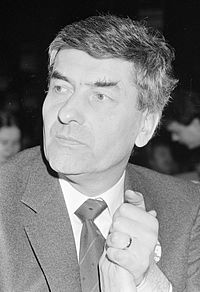 Ruud Lubbers, party leader from 1982 until 1994
Ruud Lubbers, party leader from 1982 until 1994
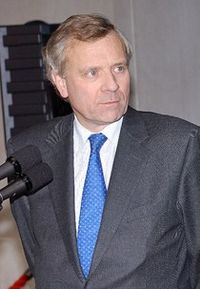 Jaap de Hoop Scheffer, party leader from 1997 until 2001
Jaap de Hoop Scheffer, party leader from 1997 until 2001
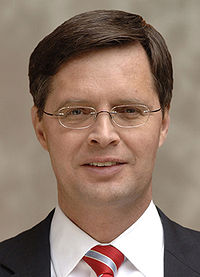 Jan Peter Balkenende, party leader from 2001 until 2010
Jan Peter Balkenende, party leader from 2001 until 2010
 Maxime Verhagen, acting party leader since 2010
Maxime Verhagen, acting party leader since 2010
Since 1880 the sizeable Catholic and Protestant parties had worked together in the so-called Coalitie. They shared a common interest in public funding of religious schools. In 1888 they formed the first Christian-Democratic government, led by the Anti-Revolutionary Æneas Baron Mackay. The cooperation was not without problems and in 1894 the more anti-papist and aristocratic conservatives left the Protestant Anti Revolutionary Party, to found the Christian Historical Union. The main issues dividing Protestants and Catholics was the position of the Dutch Representation at the Holy See and the future of the Dutch Indies.
From 1918 onward the three parties had a majority in both houses of States-General, and at least two of three parties were represented in the cabinets. This majority lasted until 1967. After the war the three Christian-Democratic parties were the Catholic People's Party (KVP), the Protestant Anti Revolutionary Party (ARP), and the Protestant Christian Historical Union (CHU). The KVP and its antecedent, the Roman Catholic State Party, had been in government without interruption since 1918.
In the sixties, the Dutch society became more secularized and the pillars faded, and voters began to move away from the three Christian-Democratic parties. In 1963 the three parties held 51% of the vote, whilst in 1972 they held only 32%. This decline forced the three parties to work closer together. In 1967 the Group of Eighteen was formed: it was a think-tank of six prominent politicians per party that planned the future cooperation of the three parties. In 1968 the three political leaders of the parties (Norbert Schmelzer (KVP), Barend Biesheuvel (ARP) and Jur Mellema (CHU) made a public appearance, stating that the three parties would continue to work together.
This caused progressive forces within the three parties, especially the ARP and KVP to regret their political affiliation. In 1968 they founded the Political Party of Radicals, a leftwing party that sought cooperation with the social-democratic Labour Party (PvdA). Locally and provincially however the three parties had long cooperated well, in some areas they formed one Christian-Democratic parliamentary party and proposed one list of candidates. In 1971 the three parties presented a common political program, which lay the foundation for the Biesheuvel cabinets.
After the disastrous elections of 1972 the cooperation was given new momentum. Piet Steenkamp, a member of the House of Representatives for the KVP was appointed chairman of a council which was to lay the foundation for a federation of the three parties, and provide a common manifesto of principles. In 1973 this federation was officially formed, with Steenkamp as chairperson.
The cooperation was frustrated by the formation of the cabinet Den Uyl, established by the leader of the social-democratic PvdA and Prime Minister of the Netherlands Joop den Uyl. Den Uyl refused to allow members of the CHU in the cabinet that he would lead. This led to a situation where the CHU, ARP and KVP formed a federation and had one parliamentary party in both houses of parliament, but only the KVP and ARP supplied ministers and junior ministers. The cabinet Den Uyl was riddled with political and personal conflicts. Another issue that split the three parties was the place the Bible would take in the new party.
Period of CDA prime ministers 1977–1994
Netherlands 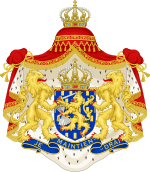
This article is part of the series:
Politics and government of
the NetherlandsConstitutionCabinetDecentralized gov'tForeign policyRelated subjects
In 1977 the parties presented a common list at the parliamentary elections, under the name Christen Democratisch Appèl. The KVP minister of Justice, Dries van Agt, was the top candidate. In the election campaign he made clear the CDA was a centrist party, that would not lean to the left or to the right. The three parties were able to stabilize their proportion of the vote.
The election result forced Van Agt to start talks with Den Uyl. The animosity between Van Agt, who had been vice-prime-minister in the cabinet Den Uyl, and Den Uyl, frustrated the talks. After more than 300 days of negotiations, they finally officially failed, and Van Agt was able to negotiate a cabinet with the conservative liberal VVD. The Cabinet Van Agt-I had a very narrow majority. The unexpected cabinet with the VVD led to split within the newly founded CDA between more progressive and more conservative members. The progressives remained within the party, and were known as loyalists. On October 11, 1980, the three original parties ceased to exist and the CDA was founded as a unitary party. After the elections of 1981, the VVD and the CDA had lost their majority, and the CDA was forced to cooperate with the PvdA. Van Agt became prime minister and Den Uyl became vice prime minister. The cabinet was troubled by ideological and personal conflicts, and fell after one year.
After the 1982 elections, a CDA/VVD cabinet was supported by a majority in parliament. The new CDA leader, Ruud Lubbers, set an ambitious reform program in motion, which included budget cuts, reform of the old age and disability pensions and liberalization of public services. Lubbers won the 1986 and 1989 elections, and he was not only supported by Christians, but also by non-religious people. In 1989 however, although the CDA had won the elections, they were unable to get a majority with their coalition partner, the VVD. The CDA was forced to cooperate with the PvdA. In the third cabinet Lubbers, the ambitious reform project was continued, with some adaptations and protests from the PvdA.
1994–present
The 1994 elections were fraught with problems for the CDA: personal conflicts between prime-minister Lubbers and lijsttrekker Elco Brinkman, a lack of support for the reforms of old age and disability pensions, and the perceived arrogance of the CDA caused a dramatic defeat at the polls. A new government was formed without any Christian Democratic ministers for the first time since 1918. The CDA was confined to the opposition. The party was marred by subsequent internal battles over leadership. The party also reflected on its principals: the party began to orient itself more toward communitarian ideals.
During the tumultuous 2002 elections, which saw the murder of Pim Fortuyn, many people voted for the CDA, hoping that this party could bring some stability to Dutch politics. The CDA led the Balkenende coalition, which included the VVD and the Pim Fortuyn List (LPF). This cabinet fell due to internal struggles within the LPF. After the 2003 elections, the Christian Democrats were forced to begin cabinet negotiations with the PvdA. Personal animosity between Balkenende and the leader of the PvdA, Wouter Bos, frustrated these negotiations. Balkenende eventually formed a coalition with the conservative and progressive liberals. The coalition proposed an ambitious program of reforms, including more restrictive immigration laws, democratization of political institutions and reforms of the system of social security and labour laws.
After the 2006 elections the CDA changed their course radically: they formed a new cabinet still led by Balkenende, but now with the social-democratic PvdA and the social-Christian ChristianUnion. The cabinet was more progressive, entailing increased government spending funded by higher taxes.[2]
In the 2010 elections the CDA lost half of its seats and became only fourth after VVD, PvdA and PVV. Balkenende announced his resignation and stayed prime minister until the formation and inauguration of the Rutte cabinet.
Ideology and issues
The CDA is a Christian democratic party, but the Bible is only seen as one source of inspiration, for individual members of parliament. The party also has Jewish, Muslim and Hindu members of parliament, and it favors the integration of minorities into Dutch culture.
The party has four main ideals: shared responsibility, stewardship, justice and solidarity. Shared responsibility refers to the way society should be organized: not one organization should control all society, instead the state, the market, and social institutions, like churches and unions should work together. This is called sphere sovereignty, a core concept of Protestant political philosophy. Furthermore, this refers to the way the state should be organized. Not one level of the state should have total control, instead responsibility should be shared between local, provincial, national and European government. This is called subsidiarity in Catholic political thought. With stewardship the Christian Democrats refer to the way we should treat our planet: the Earth is a gift from God. Therefore we should try to preserve our environment.
Practically, this means the CDA is a centre-right party. However, the party has a considerable center-left wing, that supports eco-friendly politics, a strong pro-European policy and favors centre-left coalitions. The position of the centre-left group within the party has been weakened since the party's participation in the rightist minority cabinet with the VVD (Cabinet Rutte), a cabinet that stronly depends on the parliamentary support of the PVV. CDA politicians that can be considered centrist or centre-left: Jack Biskop (MP), Ad Koppejan (MP), Kathleen Ferrier (MP; daughter of the late Johan Ferrier, president of Suriname 1975-1980), Dries van Agt (former Prime Minister), Ruud Lubbers (former Prime Minister) and Herman Wijffels (former chairman of the Social Economic Council, former informateur).
It's interesting to know that Maxime Verhagen, the informal leader of the CDA and current deputy Prime Minister, strongly denies the claim that the CDA is considered a rightist party. Verhagen continues to tell the media that his party is a centrist and moderate party and that the CDA participates in a centre-right coalition (with the VVD as the rightist component and the CDA as the centrist component)[3]. However, his colleague in the cabinet, minister of Defence, Hans Hillen, is a strong proponent of a conservative CDA.
- The state deficit should be repaid in one generation, to cope with the effects of the aging population.
- The toleration of soft drugs should come to an end, furthermore the practices of prostitution, abortion and euthanasia should be more limited.
- The party is a staunch proponent of European integration and Turkey's possible EU membership in the future.
- The party wants to make schools and hospitals more responsible for their own policy, instead of being regulated by the government.
Representation
Part of a series on Christian democracy Politics portal Prime Ministers
- Jan Peter Balkenende (2002–2010)
- Ruud Lubbers (1982–1994)
- Dries van Agt (1977–1982)
Leadership
- 2010– Maxime Verhagen (Acting)
- 2001–2010 Jan Peter Balkenende
- 1997–2001 Jaap de Hoop Scheffer
- 1994–1997 Enneüs Heerma
- 1994–1994 Elco Brinkman
- 1982–1994 Ruud Lubbers
- 1976–1982 Dries van Agt
Chairperson of the parliamentary party in the House of Representatives:
- 2010– Sybrand van Haersma Buma
- 2010–2010 Maxime Verhagen
- 2007–2010 Pieter van Geel
- 2002–2007 Maxime Verhagen
- 2001–2002 Jan Peter Balkenende
- 1997–2001 Jaap de Hoop Scheffer
- 1994–1997 Enneüs Heerma
- 1989–1994 Elco Brinkman
- 1982–1989 Bert de Vries
- 1978–1982 Ruud Lubbers
- 1977–1978 Wim Aantjes
- 2010 Jan Peter Balkenende
- 2006 Jan Peter Balkenende
- 2003 Jan Peter Balkenende
- 2002 Jan Peter Balkenende
- 1998 Jaap de Hoop Scheffer
- 1994 Elco Brinkman
- 1989 Ruud Lubbers
- 1986 Ruud Lubbers
- 1982 Dries van Agt
- 1981 Dries van Agt
- 1977 Dries van Agt
Members of the House of Representatives
Current members
Current members of the House of Representatives since the general election of 2010:
- Sybrand van Haersma Buma, Parliamentary group leader
- Jack Biskop
- Elly Blanksma-van den Heuvel
- Bas Jan van Bochove
- Hanke Bruins Slot
- Coşkun Çörüz
- Kathleen Ferrier
- Maarten Haverkamp
- Eddy van Hijum
- Raymond Knops
- Ger Koopmans
- Ad Koppejan
- Pieter Omtzigt
- Henk Jan Ormel
- Sander de Rouwe
- Margreeth Smilde
- Mirjam Sterk
- Madeleine van Toorenburg
- Sabine Uitslag
- Gerda Verburg
- Marieke van der Werf
Seats
Seats in the House of Representatives:
- 2010 – 21
- 2006 – 41
- 2003 – 44
- 2002 – 43
- 1998 – 29
- 1994 – 34
- 1989 – 54
- 1986 – 54
- 1982 – 45
- 1981 – 44
- 1977 – 48
- 1972 – 49 ... (KVP 27, ARP 14, CHU 7)
- 1971 – 58 ... (KVP 35, ARP 13, CHU 10)
- 1967 – 70 ... (KVP 43, ARP 15, CHU 12)
- 1963 – 76 ... (KVP 50, ARP 13, CHU 13)
- 1959 – 75 ... (KVP 49, ARP 14, CHU 12)
- 1956 – 77 ... (KVP 49, ARP 15, CHU 13)
Members of the Senate
Current members
Current members of the Senate since the election of 2011:
- Elco Brinkman, Senate group leader
- Sophie van Bijsterveld
- Peter Essers
- Anne Flierman
- Hans Franken
- Wopke Hoekstra
- René van der Linden
- Pia Lokin-Sassen
- Maria Martens
- Gerrit Terpstra
- Greetje de Vries-Leggedoor
Seats
Seats in the Senate:
- 2011 – 11
- 2007 – 21
- 2003 – 23
- 1999 – 20
- 1995 – 19
- 1991 – 27
- 1987 – 26
- 1983 – 26
- 1981 – 28
- 1980 – 27
- 1977 – 24
- 1974 – 29 ... (KVP 16, ARP 6, CHU 7)
- 1971 – 36 ... (KVP 22, ARP 7, CHU 7)
- 1969 – 39 ... (KVP 24, ARP 7, CHU 8)
- 1966 – 39 ... (KVP 25, ARP 7, CHU 7)
- 1963 – 40 ... (KVP 26, ARP 7, CHU 7)
- 1959 – 42 ... (KVP 26, ARP 8, CHU 8)
- 1956 – 41 ... (KVP 25, ARP 8, CHU 8)
Members of the European Parliament
Current members
Current members of the European Parliament since the election of 2009:
- Wim van de Camp, leader of the CDA delegation
- Esther de Lange
- Lambert van Nistelrooij
- Ria Oomen-Ruijten
- Corien Wortmann-Kool
Seats
Seats in the European Parliament:
- 2009 – 5
- 2004 – 7
- 1999 – 9
- 1994 – 10
- 1989 – 10
- 1984 – 8
- 1979 – 10
Local and provincial government
By far, the CDA has the most members of municipal and provincial councils in the Netherlands. Furthermore, it cooperates in most municipal and provincial governments.
Electorate
The CDA is mainly supported by religious voters, both Catholics and Protestants. These tend to live in rural areas and tend to be elderly. In some periods, however, the CDA has functioned as a centre party, attracting people from all classes and religions.
Geographically, the CDA is particularly strong in the provinces of North Brabant, Limburg and Overijssel and in the Veluwe and the Westland areas. In the 2006 elections the CDA received the highest percentage of votes in the municipality of Tubbergen, Overijssel (66,59% of the vote). The CDA is weaker in the four major cities (Amsterdam, Rotterdam, The Hague and Utrecht) and in Groningen and Drenthe.
Organization
Organization
The CDA has 69 560 members in 520 municipals branches. Its current chairperson is Ruth Peetoom.
Linked organizations
The youth movement of the CDA is the Christian-Democratic Youth Appeal (CDJA, Christen-Democratische Jongeren Appèl ). The CDA publishes the CDA-magazine monthly, and its scientific bureau publishes the Christian Democratic Explorations (Christen-Democratische Verkenningen).
As an effect of pillarization, the CDA still has many personal and ideological ties with religious organizations, such as the broadcasting societies KRO and NCRV, the paper Trouw, the employers organizations NCW and the union CNV.
The CDA participates in the Netherlands Institute for Multiparty Democracy, a democracy assistance organisation of seven Dutch political parties.
International organizations
The CDA is a member of the European People’s Party and the Centrist Democrat International. Within the EPP the CDA belongs to those parties which least favour a cooperation with the conservatives.
International comparison
As a large Christian democratic party, the CDA is comparable to other European Christian democratic parties such as Germany's Christian Democratic Union (although it's more moderate). It is the Netherlands' third largest right-wing party (after the VVD and the PVV), but it is more centrist than the British Conservative Party.
References
- ^ Score 6.1/10 in 2003 Chapel Hill expert survey, see Hooghe et al. (2003) Chapel Hill Survey
- ^ http://groups.google.com/group/nl.handicap/browse_thread/thread/0edda1e2100b05aa
- ^ http://www.tomlouwerse.nl/2010/09/cda-middenpartij-niet-volgens-eigen.html
External links
Political parties in the Netherlands House of Representatives People's Party for Freedom and Democracy (31) · Labour Party (30) · Party for Freedom (24) · Christian Democratic Appeal (21) · Socialist Party (15) · Democrats 66 (10) · GreenLeft (10) · ChristianUnion (5) · Reformed Political Party (2) · Party for the Animals (2)Senate People's Party for Freedom and Democracy (16) · Labour Party (14) · Christian Democratic Appeal (11) · Party for Freedom (10) · Socialist Party (8) · Democrats 66 (5) · GreenLeft (5) · ChristianUnion (2) · Reformed Political Party (1) · 50PLUS (1) · Party for the Animals (1) · Independent Senate Fraction (1)European Parliament Christian Democratic Appeal (EPP 5) · Party for Freedom (NI 5) · Labour Party (S&D 3) · People's Party for Freedom and Democracy (ALDE 3) · Democrats 66 (ALDE 3) · GreenLeft (G-EFA 3) · Socialist Party (UEL-NGL 2) · ChristianUnion (ECR 1) · Reformed Political Party (EFD 1)Catholic Gereformeerd Hervormd and others Non-denominational PPR · CDACategories:- Christian Democratic Appeal
- Christian democratic parties
- Confessional parties in the Netherlands
- Political parties established in 1973
- Political parties established in 1980
- Political parties in the Netherlands
Wikimedia Foundation. 2010.

